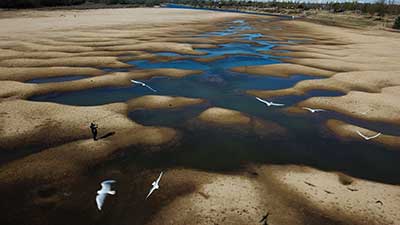Date: 17/02/2023
Relevance: GS-3: Biodiversity, Environment, Security and Disaster Management.
Key Phrases: threat-multiplier, World Meteorological Organisation, international cooperation, mass exodus, global sea level, triple the average rate
Context:
- Recently a World Meteorological Organisation (WMO) report occupied centre stage at the UN Security Council’s first-ever debate on the impact of sea-level rise on global peace.
World Meteorological Organization
- The World Meteorological Organization (WMO) is a specialized agency of the United Nations responsible for promoting international cooperation on atmospheric science, climatology, hydrology and geophysics.
- The WMO originated from the International Meteorological Organization, a nongovernmental organization founded in 1873 as a forum for exchanging weather data and research.
- Proposals to reform the status and structure of the IMO culminated in the World Meteorological Convention of 1947, which formally established the World Meteorological Organization.
- The WMO is made up of 193 countries and territories, and facilitates the "free and unrestricted" exchange of data, information, and research between the respective meteorological and hydrological institutions of its members.
- It also collaborates with nongovernmental partners and other international organizations on matters related to environmental protection, climate change, resource management, and socioeconomic development.
- Headquartered in Geneva, Switzerland, the WMO is governed by the World Meteorological Congress, composed of member states, which meets every four years to set policies and priorities.
Key Highlights:
- UN Secretary cited the document to warn of “a mass exodus of the population on a biblical scale”.
- The report — adds to the growing corpus of studies that underline the climate vulnerabilities of people living in low-lying areas.
- More than one in 10 people in the world, including those in megacities like Mumbai, New York, London, Dhaka, Shanghai and Buenos Aires, could face severe turmoil even if global warming is miraculously limited to 1.5 degrees — the Paris climate pact’s goal.
- As the WMO has warned, the rising seas are a “threat-multiplier”.
- The rushing salty waters can aggravate disparities by playing havoc with agrarian systems and ruining the livelihoods of fishing communities.

Factors Impacting Sea-Water rise:
- Meltwater from Ice:
- About two-thirds of global sea level rise is due to meltwater from glaciers and ice sheets, the vast expanses of ice that cover Antarctica and Greenland.
- In Greenland, most of the ice loss stems from warming air temperatures that melt the surface of the ice sheet, as well as calving from the glaciers that empty into the sea.
- Thermal Expansion:
- Not only is more water flowing into the ocean from ice sheets and glaciers – the warmer water of the ocean is taking up more space, adding to sea level rise.
- Ocean Circulation:
- Sea level rise isn’t consistent across the globe. Some coastal areas see triple the average rate of rise while others don’t observe any changes, or can even see a drop in sea level.
- Ocean currents, the upwelling of cold water from the deep ocean, winds, movements of heat and freshwater, and Earth’s gravitational pull all play a role in moving water masses around.
- Solid Earth Dynamics:
- It’s not only water processes that play a role in global sea level rise – ground movements can play a significant role as well.
- On a continental scale, Earth’s crust is still recovering from the last ice age. 20,000 years ago, Canada, the northeast United States, Scandinavia and other regions were weighed down by ice sheets.
- As the ice sheets melted, and the weight on the continents eased, the land surface slowly rebounded.
- The rebounding process is still occurring and can even cause other places to drop – for example, Norfolk, Virginia is sinking due to rebounding further north.
Way Forward:
- The task for policymakers is to prepare for massive social and economic dislocation.
- This will require building resilience at several levels. For instance, investing in R&D, infrastructure and warning systems to mitigate the loss of lives and property.
- Protecting coasts could require engineering, technological and ecological interventions — creating physical barriers, permeable pavements, sopping waters or reviving mangroves.
- Engineering solutions are often criticised because even the most robust protective structures deflect the energy of the waves to other areas.
- Armoured shorelines can also upset the delicate ecological balance of coastal habitats.
- In recent times, innovations to overcome such deficiencies by combining engineering and ecological approaches have been tried.
Conclusion:
- Technology and fund transfer commitments at UN summits have rarely been in proportion to the gravity of the challenge at hand — in any case, follow-up on even the most sincere commitment has been far from being adequate.
- International law may well have to engage with the requirements of people dislocated by the sea, many of them rendered stateless.
- At the same time, dealing with emergencies, mitigating hardship and preparing people to deal with the vagaries of climate will require political will and action at the level of local governments.
- In India, this could test the resolve of urban municipalities and civic bodies that have struggled to do justice to their mandate, even in normal times.
Source: The Indian Express
Mains Question:
Q. What are various factors leading to seawater rise? Discuss its impact (150 words).







